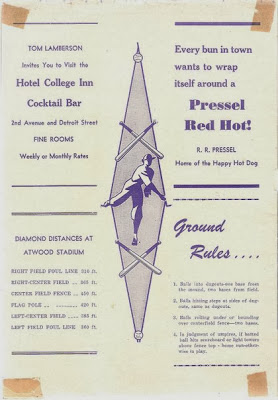Another Central League rarity, this one from the 1951 Flint Arrows. I found this on eBay shortly after buying the Flint Indians scorecard. This is the only Arrows anything I have seen online so far.
 |
| 1951 Regular Season--Arrows vs. Charleston Senators |
The Flint Arrows were the ninth minor-pro baseball team to call Flint home. They were charter members of the revived Central League, a Class A loop that featured teams in Michigan, Indiana and Ohio. The Arrows played their home games at Atwood Stadium, previously home to the Flint Indians.
The Arrows, like the Indians, were a farm team for a major league team for most of their existence. Flint was able to land the coveted affiliation with the Detroit Tigers. Buick City fans were now able to see future Tigers players begin their pro careers right in their backyard. The Tigers, in turn, named Jack Tighe as the first manager of the new Arrows.
 |
| Page 6, featuring the home schedule |
Tighe's bunch won the regular season title in their first season. The Arrows were led by the excellent hitting of
George Lerchen (.337) and strong pitching of Alex Nedelco (16-7). However, Flint was bounced from the playoffs in the first round by Fort Wayne.
In 1949, the Arrows fell to second place, and again were knocked off in the first round, this time by the Grand Rapids Jets. Flint featured catcher Frank House, one of the Tigers' "bonus babies", who was a big draw for Flint and other CL franchises that summer. Pitcher Ernie Funk, despite a 12-10 record, had a sparkling 2.13 ERA.
Tighe was replaced by Gene Desautels for the 1950 season, and his first Arrows squad was the finest in the franchise's history. Flint rolled to an 80-53 record, 8 games ahead of second-place Muskegon. In the playoffs, the Arrows zipped by both Grand Rapids and Muskegon to claim the Central League championship for the first time.
 |
| Page 7, featuring the 1951 Arrows Roster |
The bubble burst for the Arrows after the 1950 season. Desautels left and the Tigers had pulled the plug on their relationship with Flint. As a result, the Arrows were now forced to operate as an independent club. With no major league team sending down prospects, new Arrows manager Steve Bysco struggled to field a competitive lineup in 1951.
Flint plummeted to the CL cellar, just a year after winning it all. Their woeful 38-98 record was a massive 48.5 games behind league champion Dayton. Team batting average was a dismal .247, though Joe Scalise did
bat .331 with 12 home runs. No pitcher on the roster had a .500 record, and five pitchers had over 10 losses. Mel Held had the best numbers, going 11-15 with a 4.09 ERA.
Attendance collapsed at an alarming rate in 1951. A pathetic 25,900 fans bothered to show up for Arrows games that year, which is an average of 370 fans per game!
While the awful on-field product did not help the gate numbers, attendance was a problem throughout the Central League and many other minor leagues. Televised baseball games were really starting to catch on, and more and more fans decided to stay home and watch the "Game of the Week" instead of head to the ballpark and watch the local team. The Central League was so far in debt by 1951 that it simply cancelled the postseason and folded. Professional baseball would never again return to the Buick City. Atwood Stadium still exists, but replaced the natural grass field with Astro-Turf in 1969 and is used almost exclusively for high school football.
Again, another one of my favorite programs. The fact that it was from 1951 makes it even more special. This was the last professional baseball club to play in Flint. And judging by the shape that city is in now, it likely will always be the last one. But look at that attendance number in '51, that's what really makes this program rare.
 |
| Back Cover, featuring dimensions and ground rules |
The back cover is one of my favorites of this program. On this page, it gives the dimensions and ground rules for Atwood Stadium as a baseball field. Atwood, shown here, is a C shaped stadium, much more suited for football. Home plate was in one of the corners (not sure which one).
As you can see by the numbers, right field was a pretty short distance from home plate. Center field, however, was a different story. Tiger Stadium was famous for it's 420-foot center field. Atwood Stadium had it beat, with a mammoth 450 feet to dead center. It would take a huge swing in any era to homer to dead center in this ballpark.
Sources:
Okkonen, Marc. Minor League Baseball Towns of Michigan: Adrian to Ypsilanti. pages 52-53. Thunder Bay Press, 1997.
Atwood Stadium pictures. Eric and Wendy Pastore, Digital Ballparks.com.
Flint Arrows Statistics: 1951 (from Baseball-Reference.com)
Thanks for taking the time to discuss that, I feel strongly about this and so really like getting to know more on this kind of field. Do you mind updating your blog post with additional insight? It should be really useful for all of us. bestsportsgearhub.com
ReplyDelete